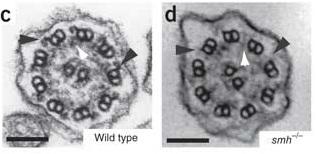Special Issue: Water Narratives
24 December 2025
Published online 21 May 2012

Cilia are small, hair-like structures that protrude from cells lining several organs, such as kidneys, lungs, and the spinal canal. Defects in cilia motility mean they are unable to perform their different functions, a condition known as primary ciliary dyskinesia (PCD) which affects one in every 15,000 – 30,000 children.
A team of international researchers, including Dalal Al-Mutairi, a pathologist at Kuwait University, found that mutations to the gene CCDC103 led to PCD, publishing their results this week in Nature Genetics. The gene joins over a dozen others identified to be critical for proper cilia function.
Cilia movement is controlled by dynein arms, a subunit of cilia that converts chemical energy from ATP into mechanical energy, powering the beating movement of cilia. The researchers studied schmalhans, a mutant form of the model zebrafish with cilia paralysis. Using electron microscopes, schmalhans were found to lack two important parts of the dynein arms. When zebrafish embryos were injected with human, non-mutated CCDC103 mRNA, cilia movement was restored, suggesting the gene is essential for dynein arm assembly and the beating ciliary action. Injecting mutated CCDC103 into schmalhans aggravated PCD.
The researchers also screened 146 unrelated families with at least one member with PCD and identified 6 families with individuals carrying a mutation in CCDC103.
The researchers suggest that further studies should look at how CCDC103 works with other proteins to form the dynein arms and how they control cilia.
doi:10.1038/nmiddleeast.2012.77
Stay connected: